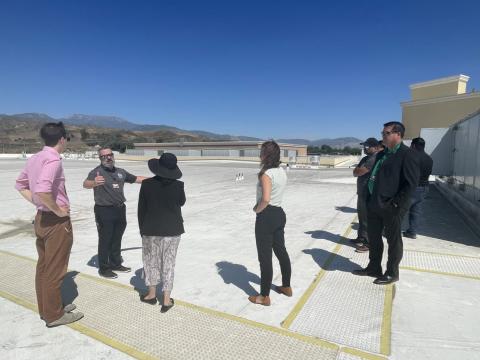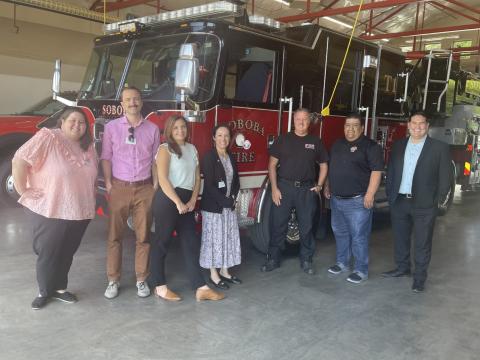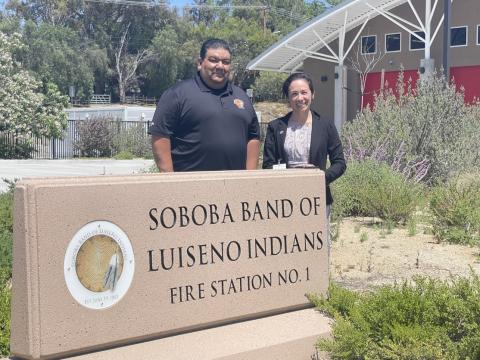California Energy Commissioner Noemi Gallardo visited the Soboba Band of Luiseño Indians June 21 to recognize the Tribe’s implementation of clean energy solutions, including the installation of a solar microgrid on its reservation.
“We were impressed by the scale and extent of Soboba’s accomplishments towards their clean energy transition through the adoption of advanced clean energy technologies and incorporating robust energy conservation measures,” said Michael Ward, spokesman for the California Energy Commission (CEC). The commission earlier awarded the Tribe a $1.7 million grant from its Electric Program Investment Charge program to demonstrate the microgrid technology at the fire station.
During the visit, Gallardo met with youth Tribal members at the fire station, who are part of the Fire Explorers Program. She also toured the carport where solar is installed as part of the microgrid project and learned about the Tribe’s future clean energy plans. In addition, she discussed with Tribal members opportunities to host workshops for other Tribes at the reservation.
The CEC is impressed with the Tribe’s long-term commitment to clean energy,” said Sean Anayah, an energy specialist with the CEC Energy Research and Development Division.
“Soboba has strategically invested in clean energy projects over time, leveraging a variety of financial resources, and creating an effective model that other Tribes and communities can duplicate,” he said.
Soboba Tribal Council expressed their appreciation for the visit from Gallardo. “We were pleased to host Commissioner Gallardo and show her all that the Tribe is doing to move toward energy resilience and a clean energy future.”
The Soboba Reservation is located in a high-fire risk region in the foothills of San Jacinto, California and often experiences power outages due to fires or public safety power shutoff (PSPS) events, which are implemented by Southern California Edison (SCE) when fire risk is high. The Tribe’s power outages last seven hours on average but can be as long as 24 hours during high wind conditions and PSPS events.
The fire station microgrid consists of solar photovoltaics located on a carport plus a battery storage system. The microgrid is connected to the larger electricity grid but can also isolate from the grid. In that case, the installation produces power independently during grid outages and PSPS events.
The microgrid can power both the Tribe’s fire station and emergency operations center and helps provide critical services to the Tribe and the surrounding community through mutual aid agreements, Ward added.
During an outage, the Tribe’s fire station and emergency response facility have no power, which limits the Tribe’s ability to provide critical resources and potentially life-saving responses during an emergency or disaster, Anayah said. The project aims to decrease the negative effects of PSPS events and grid outages and demonstrate an innovative battery storage system that can provide the community with at least 10 hours of electricity during outages, which is longer than traditional energy storage systems. If the Tribe deploys more solar, the microgrid could produce power for more than 24 hours, Anayah said.
The battery system is called an advanced vanadium redox flow long-duration energy storage battery, he said.
Microgrid power supplied during power outages in the high-fire threat area is especially valuable because the Tribe can provide emergency services that boost safety. The clean energy system also yields public health, economic and energy security benefits.
With the microgrid operating, the Tribe relies less on diesel generators during power outages, which lowers greenhouse gas and other polluting emissions. Construction and installation of the system also created jobs, which helped develop the local economy and workforce. And the system provides energy security because the Tribe can generate power on-site. The microgrid also helps support the grid when it’s stressed by harsh weather, Anayah said.
“These energy investments not only result in greater energy reliability but also lead to cost savings over time,” said Katrina Leni-Konig, CEC deputy public advisor and tribal liaison.
Through the CEC grant funding, the Tribe and CEC will validate the microgrid’s performance as a system that provides long-duration energy storage, energy resiliency during power outages and services to the grid. Those grid services include load shifting and peak shaving, which involve directing the microgrid to store solar energy and release it during high-electricity demand periods to lower the burden on the grid.
As part of the project, the CEC will collect data about the microgrid’s capital cost, operating cost, performance and lessons learned to support commercial deployment of microgrids that use the advanced battery system, said Anayah. The microgrid is a demonstration case for similar systems that can be sited in tribal, remote and disadvantaged communities across the state, said Anayah.
The Tribe and CEC already learned one lesson from the project. The battery couldn’t conduct a “black start” during a grid outage because it didn’t have auxiliary power to activate it. The Tribe added an uninterruptible power supply as backup which allows the system to start up during outages, Anayah said.
The microgrid project is part of a larger effort from the CEC to support Tribes’ efforts to achieve energy independence with clean energy.
“Earlier this year, the CEC adopted a resolution committing to continue to support tribal energy sovereignty and to work closely with tribal leaders to advance clean energy in ways that benefit tribal communities and ultimately achieving a 100% clean energy future for all Californians,” said CEC Commissioner Gallardo.
The microgrid is not the Tribe’s first clean energy project.
In 2016, the Tribe received a $500,000 grant from the federal Department of Energy’s Office of Indian Energy Tribal Energy Deployment Program to help develop a 1 megawatt solar system that generates 1.8 million kilowatt-hours a year and can meet 92% of the annual energy needs of the country club at Soboba Springs. It’s expected to save more than $6 million over 20 years, money that can be directed to other community needs.
A number of funding opportunities are available to California Native American Tribes for supporting the transition to clean energy. The funding available can support the installation of electric vehicle infrastructure, building decarbonization, energy research and development and other opportunities, said Leni-Konig.
“We invite Tribes interested in clean energy to reach out to the CEC. We are happy to discuss the opportunities available for funding renewable energy projects and to learn how we can better serve tribal communities in their transition to clean energy,” said Gallardo.
Photos courtesy of the Soboba Band of Luiseño Indians




